|
With most bodybuilders and fitness buffs, there is usually one muscle group that ends up being an afterthought in their
training. More often then not, that muscle group is the calves. No matter how impressive a physique looks, without a good
set of calves and forearms is that physique ever truly complete? We will save the forearm talk for another time but for now
let us focus in on the calves. Too often, calf training is basically overlooked. A powerful set of calves can be like the
finishing detail on really hot car. Think about when you see a beautiful woman in a skirt and high heels, when she has strong
shapely calves, it really makes her legs stand out. Now think about when you
see someone with a pair of big powerful thighs but non-existent calves, looks kind of odd to say the least.
The Tale of Genetics-
How many times have you heard someone say “The reason my calves can’t grow is because of bad calf genetics.”
Sure genetics does play a role in muscle development but so does hard work.
More often then not, this is just an excuse for avoiding hard work. For
a lot of people, calf training consists of a few half assed sets of raisers thrown in after their ‘main” muscle
groups. Truth is a lot of what people refer to training their calves is simply bullshit. Ever look at the calves of a woman
that wears high heels a lot? Generally a woman that wears high heels a lot usually has a pretty nice set of calves. So does
that mean women that wear high heels a lot just all happen to have superior genetics for calf development or is there something
to their calves having to work for long periods of time. What about the sheer size of the calves on a large overweight person?
Their calf size always seems to grow when their overall body size grows. So while
genetics do play somewhat of a role, I believe well developed calves can still
be built with some good old fashioned hard work.
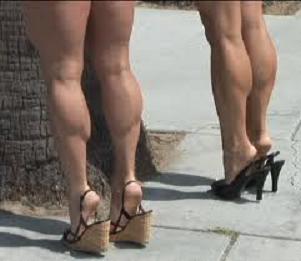
The Anatomy of the Calves-
Let’s get a better understanding of the calf muscles by seeing how they work. The calves are made up of three
major muscles. The Gastrocnemius
makes up the large bulgy part of the calf muscle. The Gastrocnemius is made up of two heads. They are the medial and lateral
heads. When these two heads are well developed the calves get a diamond like shape.
The Gastrocnemuis attaches to the heel with the Achilles Tendon and originates behind the knee on the leg, crossing
two joints. The Gastrocnemius helps with plantar flexation (elevating of the heel) and to a small extent knee stability.
The third major muscles in the calves are the Soleus. The Soleus runs underneath the Gastrocnemius on the rear of the
lower leg. The Soleus functions just like the Gastrocnemius except it comes into play when the knee is bent rather then straight.
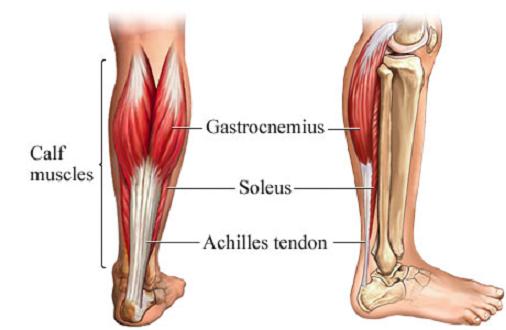
Training Specifics-
To effectively train calves, a person should take a few things into consideration. The first thing is to actually train
the calves with the same intensity as they would their other muscles. A person uses their calf muscles everyday so those muscles
can endure a lot. This means in turn it is going to take a lot to build a good set of calves. The best way to build calf muscles
is to use a variety of rep ranges, poundage, stretching, and flexing.
Rep Ranges-
Knowing how to effectively work each head of the calves will help a person in their quest for larger calves. Certain
heads are made up of mostly fast twitch muscles, while others are made up of mostly slow twitch fibers.
The Gastrocnemius muscles are made up of mostly fast twitch fibers so heavy heavy low reps in the range of 5-7 will
probably work best for training them.
The Soleus muscles are made mostly of slow twitch muscle fibers, so to effectively train them higher reps in the range
of 12-20 would probably work best.
Stretching and Flexing-
Stretching and flexing can play a huge role if a person is having trouble making their calves grow. Stretching can help
stretch out the fascia tissue. Fascia tissue is fibrous connective tissue that surrounds muscles, muscle groups, blood vessels,
and nerves. Since fascia tissue is so tough, it does not allow a lot of room for expansion. The lower leg calf area has tons
of fascia tissue due to it’s heavy weight bearing needs. By stretching out fascia tissue, this allows the muscle bellies
room to grow, better circulation in muscles, and the ability for more nutrients to reach muscle cells. Since the goal is to
improve muscle size, it is always best to stretch the muscles when they are pumped full of blood. Flexing helps with stretching
muscle tissue and increasing muscle pumps.
Calf Training Exercises-
Donkey Calf Raisers-
The Donkey Calf Raisers is an excellent exercise for hitting the Gastrocnemius muscles. The key to these is to do them
heavy, fully extend at the top and fully stretch at the bottom. These can be done with a Donkey Calf Raiser Machine, someone
sitting on your back, with a dipping belt or with a Smith Machine.
Target Muscle: Gastrocnemius
Rep Range: 5-8
reps
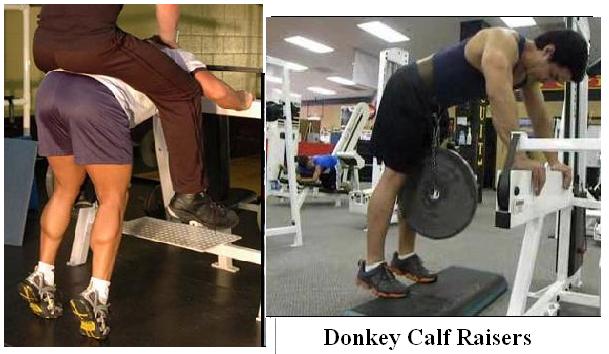
Power Standing Calf Raisers-
The Power Standing Calf Raiser is different than your normal standing calf raiser because of the workload put into them.
The key is to use a weight that you can normally do for 10 reps and perform 1 brutal set of 30 reps with it. Yes I did say
30! Just continue nonstop until you hit 30 reps. Every rep you want a two second pause at the top and full stretch at the
bottom. The object of these is to try and keep the best form possible while “powering” thru your reps.
Target Muscle: Gastrocnemius
Rep Range: 30
reps
Dumbbell Calf Jumps-
Here is another exercise that is great for building mass and really hitting the Gastrocnemius muscles. With a dumbbell
held in each hand raise up on your tippy toes. From there jump a few inches off of the ground. The key here is not to try
and jump as high as you can but to just get a few inches off of the ground and making sure to go up on your tippy toes before
you begin each jump.
Target Muscle: Gastrocnemius
Rep Range: 5-8
reps
Leg Press Calf Raisers-
Since the Gastrocnemius muscles really needy to be hit heavy, this exercise is great for adding the poundage. With the
leg press sled as person can uses a lot more weight than they might be able to use doing standing calf raisers.
Target Muscle: Gastrocnemius
Rep Range: 5-8
reps
Sitting Calf Raisers-
Sitting calf raisers are probably the best exercise for hitting the Soleus muscles. With the sitting calf raisers you
really want to pump up the reps to get a better effect. For these you can use a sitting calf raiser machine or simply a barbell
and a block of wood.
Target Muscle: Soleus
Rep Range: 20
reps
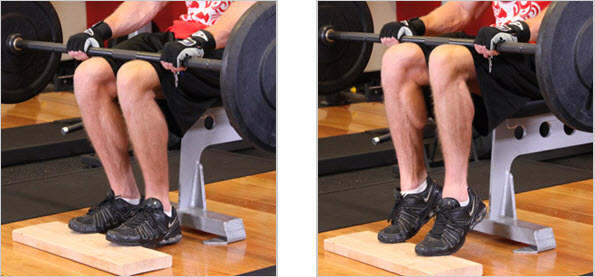
Century Club Sitting Calf Raisers-
This exercise gives new meaning to the term “high reps”. Use this last in your calf workout. 1 set of sitting
calf raisers for 100 reps! If it isn’t bad enough you have to do 100 reps, remember you have to do this after you have
done everything else. Don’t sacrifice form just to rush thru your reps. Do as many possible reps as you can in good
form. Whenever you have to stop pause for ten seconds then continue on until you finally reach 100 reps.
Target Muscle: Soleus
Rep Range: 100
reps
While developing a good set of calves may a little harder than developing
some other muscles in the body, with some good old fashion hard work a good set of calves can also be built. By varying rep
ranges, stretching, and targeting specific muscles you may be on your way from developing calves to developing bulls.
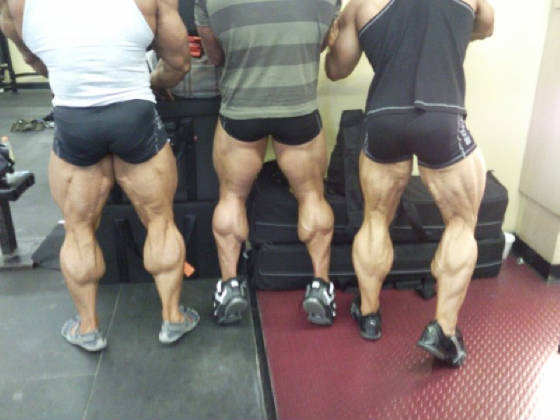
|

